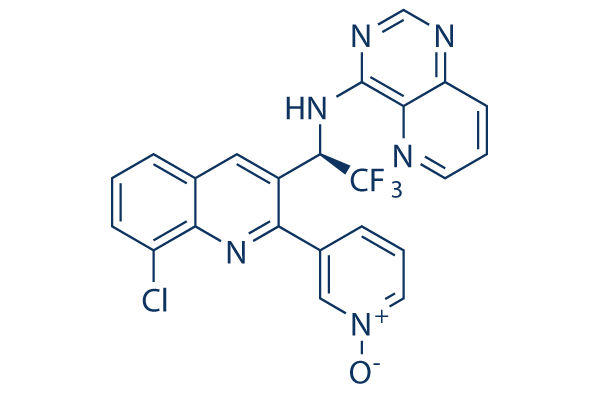|
受注:045-509-1970 |
技術サポート:tech@selleck.co.jp 平日9:00〜18:00 1営業日以内にご連絡を差し上げます |
化学情報

|
Synonyms | N/A | Storage (From the date of receipt) |
3 years -20°C powder | |||||||||||
| 化学式 | C23H14ClF3N6O |
||||||||||||||
| 分子量 | 482.85 | CAS No. | 1362850-20-1 | ||||||||||||
| Solubility (25°C)* | 体外 | DMSO | 97 mg/mL (200.89 mM) | ||||||||||||
| Ethanol | 97 mg/mL (200.89 mM) | ||||||||||||||
| Water | Insoluble | ||||||||||||||
| 体内 (毎回新しく調製した物を用意してください) |
|
||||||||||||||
|
* <1 mg/ml means slightly soluble or insoluble. * Please note that Selleck tests the solubility of all compounds in-house, and the actual solubility may differ slightly from published values. This is normal and is due to slight batch-to-batch variations. |
|||||||||||||||
溶剤液(一定の濃度)を調合する
生物活性
| 製品説明 | Seletalisib (UCB-5857) is a novel small-molecule inhibitor of PI3Kδ with an IC50 value of 12 nM and shows significant selectivity to PI3Kδ with respect to the other class I PI3K isoforms (between 24- and 303-fold). |
|---|---|
| in vitro | Seletalisib (UCB-5857) is a potent, ATP-competitive, and selective PI3Kδ inhibitor able to block protein kinase B (AKT) phosphorylation following activation of the B-cell receptor in a B-cell line. Moreover, it inhibited N-formyl peptide-stimulated but not phorbol myristate acetate–stimulated superoxide release from human neutrophils, consistent with a PI3Kδ-specific activity. Findings from cellular assays of adaptive immunity demonstrated that this compound blocks human T-cell production of several cytokines from activated T-cells. Additionally, it inhibited B-cell proliferation and cytokine release. In human whole blood assays, seletalisib inhibited CD69 expression upon B-cell activation and anti-IgE-mediated basophil degranulation. From 239 kinases screened, it at a concentration of 10 μM showed no inhibitory activity greater than 47% (MAP4K4) against non-PI3K kinase enzymes. Against nonkinase enzymes, it showed weak activities against phosphodiesterase (PDE)3A, PDE2A1, and PDE4D2, with inhibition varying between 32 and 74% at 10 μM. When screened at a concentration of 10 μM against 55 receptors and ion channels, the highest inhibitory activity of seletalisib observed was 20%. One receptor, neuropeptide Y receptor (Y1) showed 54% activation. In vitro receptor binding and enzyme assays across a broad range of target classes showed that it is selective for PI3Kδ. This compound potently inhibited the phosphorylation of AKT following anti-IgM stimulation of the BCR on Ramos cells with an IC50 of 15 nM[1]. When profiled in a wide range of primary cell assay systems, including fibroblasts, epithelial, endothelial and vascular smooth muscle cells, it showed significant activity only in those systems containing lymphocytes, demonstrating its functional selectivity towards PI3Kδ-expressing cells[2]. |
| in vivo | Seletalisib (UCB-5857) shows dose-dependent inhibition in an in vivo rat model of anti-CD3-antibody-induced interleukin 2 release. Analysis of the relationship between inhibition of IL-2 release and its blood concentration, using combined data across experiments, demonstrated that this compound has potent in vivo effects with an estimated IC50 value of <10 nM[1]. In first-in-man studies, mean plasma concentration-time profiles increased with increasing dose after single and multiple dosing, with no major deviations from dose proportionality. There was no unexpected accumulation or loss of exposure after multiple dosing (time-independent pharmacokinetic (PK) profile) and apparent t1/2 values (approx. 20h) were supportive of once-daily dosing[2]. |
プロトコル(参考用のみ)
| キナーゼアッセイ | In Vitro Kinase Activity Assays and Off-Target Profiling | |
|---|---|---|
| The activities of seletalisib (UCB-5857) and the pan-PI3K inhibitor UCB1370037 were tested in biochemical kinase assays of the PI3Kα, PI3Kβ, PI3Kδ and PI3Kγ (manufactured in-house) isoforms. Competitive time-resolved (TR) fluorescence resonance energy transfer (FRET) assays using a four-step PI3K assay reagent kit were performed. In this assay, PI3K activity is measured by the detection of phosphatidylinositol triphosphate (PIP3) as follows: A complex is formed between biotinylated PIP3 and a glutathione S-transferase (GST)-tagged pleckstrin homology–domain protein, which are detected by streptavidin-allophycocyanin (APC) and europium-labeled anti-GST antibody, respectively. Proximity of the two fluorophores results in a stable TR-FRET signal. The production of unlabeled PIP3 by PI3K in the kinase reaction results in competitive inhibition of the complex and therefore the FRET signal. Briefly, 2 μl of compound was added to wells containing 8 μl of a mixture containing phosphatidylinositol bisphosphate (PIP2) substrate and ATP, before addition of 10 μl of PI3K (prediluted to the required concentration). The final assay concentrations of ATP and PIP2 substrate were 2 μM and 10 μM, respectively. The final assay concentration of PI3K enzymes was 1–8 nM depending on batch activity. The final assay concentration of DMSO was 2.0%. The plate was incubated at room temperature for 30 minutes before addition of stop buffer and detection buffer according to manufacturer instructions, and the plate was then incubated for a further 6 hours at room temperature. TR-FRET measurements were performed on an Analyst GT plate reader. The ATP concentration dependence of the activity of this compound against PI3Kδ was established by running the assay in the presence of varying ATP concentrations (2, 40, 200, and 1000 μM). The final assay concentrations of PI3Kδ and PIP2 substrate in these assays were 1 nM and 25 μM, respectively. | ||
| 細胞アッセイ | 細胞株 | Ramos B-cell line |
| 濃度 | 0.1 nM-10 μM | |
| 反応時間 | 10 min | |
| 実験の流れ | Serially diluted seletalisib (UCB-5857) and goat anti-human F(ab)2 IgM in serum-free RPMI 1640 were added to Ramos cells plated in serum-free RPMI 1640. The plate was incubated for 10 minutes, chilled on ice, and the cells pelleted by centrifugation. Cellular phosphorylated AKT was detected by MSD assay. |
|
| 動物実験 | 動物モデル | Adult Lewis rats (male, 6-8 weeks of age) |
| 投薬量 | 0.1-10 mg/kg in 500 μl volume | |
| 投与方法 | via oral gavage | |
参考
|
Selleckの高級品が、幾つかの出版された研究調査結果(以下を含む)で使われた:
| The phosphoinositide-3-kinase (PI3K)-delta inhibitor seletalisib impairs monocyte-derived dendritic cells maturation, APC function, and promotes their migration to CCR7 and CXCR4 ligands [ J Leukoc Biol, 2022, 10.1002/JLB.1A0821-413RR] | PubMed: 35199885 |
長期の保管のために-20°Cの下で製品を保ってください。
人間や獣医の診断であるか治療的な使用のためにでない。
各々の製品のための特定の保管と取扱い情報は、製品データシートの上で示されます。大部分のSelleck製品は、推薦された状況の下で安定です。製品は、推薦された保管温度と異なる温度で、時々出荷されます。長期の保管のために必要とされてそれと異なる温度で、多くの製品は、短期もので安定です。品質を維持するが、夜通しの積荷のために最も経済的な貯蔵状況を用いてあなたの送料を保存する状況の下に、製品が出荷されることを、我々は確実とします。製品の受領と同時に、製品データシートの上で貯蔵推薦に従ってください。
